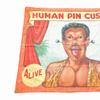George Washington's Diamond Eagle Medal On Display With Newly-Discovered 7-Foot Watercolor in Philadelphia Exhibition
- December 06, 2017 12:12
The Diamond Eagle — an exquisite jewel-encrusted medal owned and worn by George Washington — is now on display in Philadelphia for the first time since it was presented to Washington in the city 233 years ago, and it will be shown this winter with a rare, newly-found Revolutionary War-era artwork.
The medal display will coincide with the Museum of the American Revolution’s upcoming exhibition of a recently acquired watercolor painting by Pierre Charles L’Enfant, who also designed the medal. The painting depicts the Continental Army’s encampment at Verplanck’s Point, New York, in 1782, and includes the only known wartime depiction of Washington’s War Tent (also on view).
On display from Jan. 13 – Feb. 19, 2018, and entitled Among His Troops: Washington’s War Tent in a Newly Discovered Watercolor, the limited-run exhibit will bring together works of art, weapons, and other artifacts from the Revolutionary War to explore the history surrounding the remarkable recent discovery of this painting by the museum’s curators.
“Seeing this painting is like traveling back in time. To have such a detailed depiction of the scene painted by an eyewitness...is like having a Google Street View look at a Revolutionary War encampment,” explained Philip Mead, the chief historian at the new museum in Philadelphia.
(Read more about the curators' exciting discovery at Heritage Auctions in the New York Times.)
The 235-year-old, seven-foot panoramic painting offers an invaluable glimpse into the Revolutionary War, a time before the invention of photography. The sweeping watercolor painting of a 1782 Continental Army encampment contains the only known wartime depiction of General Washington’s headquarters tent, which is dramatically presented at the museum. The painting depicts hundreds of military tents arrayed across the rolling landscape of the lower Hudson Valley. Perched on a hilltop rising above the scene is Washington’s field headquarters, including the marquee tent in which he lived during the Revolutionary War.
The Diamond Eagle is the badge of office of the president general of the Society of the Cincinnati, an organization founded by officers of the Continental Army at the end of the Revolutionary War to preserve the memory of the American Revolution for all time. Members of the Society wear a gold Eagle insignia. The officers of the French Navy commissioned the Diamond Eagle — fashioned in gold and silver and embedded with nearly 200 diamonds, emeralds, and rubies — as a special tribute to Washington.
The Diamond Eagle was presented to George Washington in May 1784 at Philadelphia’s City Tavern, just steps away from the Museum, during the first general meeting of the Society of the Cincinnati. The name “Cincinnati” was taken from the heroic Roman general Cincinnatus, who relinquished dictatorial powers after saving the Roman republic from invasion. The modern Society of the Cincinnati is the oldest patriotic organization in the United States and created the American Revolution Institute in Washington, D.C., to fulfill the historic mission assigned to the Society by George Washington and his fellow officers. The Diamond Eagle is the most prized possession of the Society.
Pierre Charles L’Enfant, a French-born military engineer who is most renowned as the master planner of Washington, D.C., served in the American Revolution and designed the Society’s insignia, basing it on the American Bald Eagle. In 1783, L’Enfant traveled to France to have the Eagle made by Parisian goldsmiths. Officers of the French Navy commissioned the Diamond Eagle, and L’Enfant carried it with him in 1784 on his return to Philadelphia and presented it to Washington on their behalf.
Originally a surprise gift to Washington, the first President General of the Society, the Diamond Eagle became the badge of the office of President General. It continues to be passed down to each President General of the Society of the Cincinnati as part of their induction into office. The Eagle is the only object once owned by Washington that has been in continuous use for the purpose for which it was created.
When Washington died on December 14, 1799, the Diamond Eagle was among his personal possessions at Mount Vernon. His widow, Martha Washington, had the Diamond Eagle sent to Alexander Hamilton, who was elected the following year as the successor to Washington as President General of the Society. Following Hamilton’s untimely death in 1804, the Diamond Eagle was sent by his widow to South Carolinian Charles Cotesworth Pinckney, upon his election as the third President General in 1805. Pinckney donated the Diamond Eagle to the Society in 1811.




















